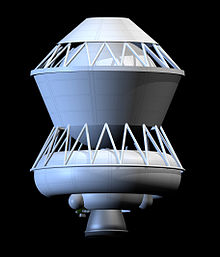Block DM

Blok DM
|
|
| Country of origin | Soviet Union |
|---|---|
| Used on | N-1, Proton and Zenit-3 |
| General characteristics | |
| Height | 6.28 m (20.6 ft) |
| Diameter | 3.70 m (12.1 ft) |
| Gross mass | 17,360 kg (38,270 lb) |
| Propellant mass | 15,220 kg (33,550 lb) |
| Empty mass | 2,140 kg (4,720 lb) |
| Associated stages | |
| Family | Blok D |
| Derived from | Blok D |
| Derivatives | Blok DM-03 |
| Comparable | Briz-M |
| Launch history | |
| Status | Retired |
| Total launches | 66 |
| First flight | 1974-03-26 |
| Last flight | 1988-05-06 |
| Engine details | |
| Engines | RD-58M |
| Thrust | 83.61 kN (18,800 lbf) |
| Specific impulse | 363.5 s (3.565 km/s) |
| Burn time | 630 seconds |
| Fuel | RG-1/LOX |
Blok D (Russian: Блок Д meaning Block D) is an upper stage used on Soviet and later Russian expendable launch systems, including the N1, Proton-K and Zenit.
The stage (and its derivatives) has been included in more than 320 launched rockets as of 2015[update]. By 2002 its modification Blok DM had a 97% success rate in 218 flights since 1974, and 43 successful missions in 1997-2002.
The stage was developed in 1960s as the fifth stage ('Д' is the fifth letter in the Cyrillic alphabet) for the Soviet Moonshot N1 rocket. The stage first flew in March 1967 while testing Zond of the moonshot program system. During manned lunar flight Blok D would be used for mid-course corrections on the flight to the Moon, then to place the lunar orbiter and lander into a lunar orbit, and decelerate moon-lander out onto its landing trajectory.
Blok D was also included as fourth stage of Proton rocket and as such flew on unmanned Soviet missions to Moon, Mars and Venus. It was used in the Proton-K configuration of the rocket and is still in use in the newer Proton-M variant (along with the Briz-M).
Blok DM also flies as the third stage for Zenit-3SL rocket, which is used by the Sea Launch project to launch geostationary satellites. In 2002 the failure of a Blok DM3—used in the attempted launch of Astra 1K—caused considerable concern.
...
Wikipedia
